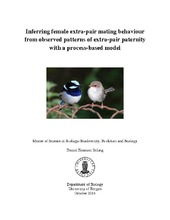| dc.description.abstract | There has been great focus on extra-pair paternity (EPP) in birds over the last decades. The knowledge gained has made researchers rethink certain notions about mating behaviour in birds. Initially it was believed that socially monogamous birds were also sexually monogamous. It is hard to observe EPC behaviour in nature and EPC may not necessarily lead to extra-pair fertilization. Therefore, molecular methods may help us estimate the proportion of females with EPC behaviour. It has been found through molecular methods that there is high variation in EPP levels between species and populations. In this study, we mainly investigate how well EPP levels can be used to make inferences about the underlying mating behaviour that causes EPP. We used a process-based model as a virtual laboratory' in order to simulate populations of socially monogamous and sexually polyandrous females. Our findings suggest that it is hard to make inferences about extra-pair copulation (EPC) behaviour (1) when the proportion of extra-pair young (EPY) in a population is small, (2) when the clutch size is small, and (3) when the sample size is limited. Researchers working in the field should be cautious when drawing conclusions about the proportion of females with EPC behaviour based on EPP levels. | en_US |
